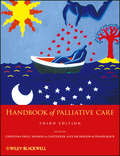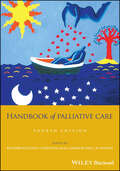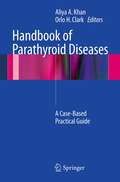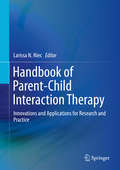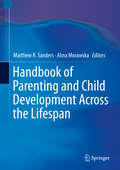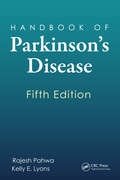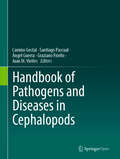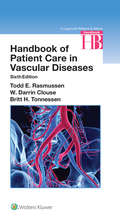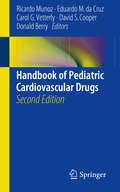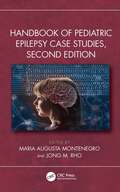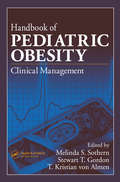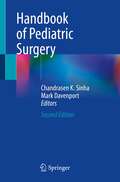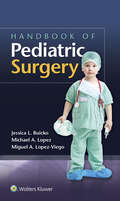- Table View
- List View
Handbook of Palliative Care
by Sharon De Caestecker Fraser Black Alex Nicholson Christina FaullA Practical and Comprehensive Introduction to the Field of Palliative Medicine"This is not so much a handbook of palliative care as the handbook of palliative care." -Palliative MedicineThe Third Edition of the BMA's 1999 Medical Book of the Year provides valuable insights into the complex issues that arise in the delivery of palliative care. It is an invaluable resource for anyone involved in palliative care no matter what the setting-be it hospital, hospice, or community.Handbook of Palliative Care, Third Edition provides the what, how, and why of palliative care, helping providers follow best practices developed by specialists and supported by available research. It handily combines clinical practice and theoretical concepts in a succinct format, making the latest knowledge easy to find and apply.The Third Edition provides:Comprehensive and authoritative information as well as thorough detail on how to apply itGuidance from UK and North American clinicians who are experts in their fieldUp-to-date overviews of medicine management and complementary medicine in palliative careConsiderations of audit and ethical issues in palliative medicineNew chapters tackling important issues like Choice, Equality, and Diversity; Dementia; and Advance Care PlanningA thoroughly revised chapter on cancer complications including the latest on lymphoedemaThis Third Edition of Handbook of Palliative Care is the book for doctors, nurses, therapists, pharmacists, social workers, family members, and anyone involved with or providing palliative care. The First Edition was the winner of the 1999 BMA Medical Book of the Year Prize.
Handbook of Palliative Care
by Christina Faull Sarah Russell Richard Kitchen Jo WilsonHandbook of palliative care Comprehensive resource utilising up-to-date evidence and guidelines to support non-specialists in palliative care in both hospital and community settings Building on the success of previous editions, this new edition of the award winning handbook has a practical focus and provides the user with an approach to clinical challenges while also providing enough information to explain why this approach is suggested. The 4th edition of Handbook of Palliative Care supports non-specialists in palliative care in both hospital and community settings and focuses on holistic care and therapeutic interventions. With several new chapters and content significantly updated to reflect new evidence and practice, the 4th edition also presents up-to-date evidence, guidance in a succinct format and utilises flow charts and figures to enhance the accessibility of information. Written by four highly accomplished nursing and medical authors with over 100 years’ experience between them in hospital, hospice, care home and community settings, Handbook of Palliative Care provides: Guidance from clinicians who are experts in their field An acknowledgment of the requirements of healthcare professionals attending to patients with palliative care needs, along with a dedicated chapter addressing this topic Contemporary guidance on medicine management, symptom control and managing complications of cancer Palliative care in heart failure, renal disease and advanced liver, neurological and respiratory diseases An in-depth look at patient and public involvement in palliative care and inequity Skill development including communication, ethical considerations and spiritual care New chapters including frailty, dementia, and multi-morbidity; and palliative care for people living with mental illness and people with intellectual disabilities This 4th edition of Handbook of Palliative Care is an ideal supporting resource for doctors, nurses and other healthcare professionals caring for patients with palliative care needs in the UK and beyond. The 1st edition was the winner of the 1999 BMA Medical Book of the Year Prize.
Handbook of Parathyroid Diseases
by Orlo H Clark Aliya A. KhanThe Handbook on Parathyroid Diseases presents a comprehensive and concise overview of our current knowledge in the area of parathyroid function, hormone regulation and disease states. The Handbook educates the reader using a case-based approach presenting current evidence in the field. The material is presented in an easy to read and understandable language and uses a plethora of tables and text boxes where possible. Complex concepts are conveyed in simple and clear language. Leading international experts contribute to this state of the art book providing a true depth of knowledge and practicality.
Handbook of Parent-Child Interaction Therapy: Innovations and Applications for Research and Practice
by Larissa N. NiecThis handbook examines advances in the evidence-based behavioral family intervention, parent-child interaction therapy (PCIT). It surveys innovative adaptations tailored to specific diagnostic concerns, client populations, treatment settings, and delivery formats. Chapters provide rationales for adaptation, reviews of relevant research, and discussions of advantages and challenges. Case studies illustrate the implementation of the adaptations and help to make new techniques concrete. The handbook offers practical descriptions of the adaptations to PCIT, comprehensively reviews treatment outcome literature, and integrates cutting-edge implementation science into an exploration of the current dissemination strategies in PCIT. The handbook concludes with a consideration of the questions that remain to be addressed to extend the reach of PCIT among traditionally underserved families and to continue to advance the science and practice of children’s mental health interventions. Featured topics include:PCIT for children with callous-unemotional traits.PCIT for families with a history of child maltreatment.Group PCIT.PCIT for military families.The PCIT CALM program for treating anxiety in young children.PCIT for American Indian families.Transporting and disseminating PCIT internationally.Using technology to expand the reach of PCIT. The Handbook of Parent-Child Interaction Therapy is a must-have resource for researchers, professors, instructors, clinicians, and graduate students in child and school psychology, child psychiatry, and social work as well as such related disciplines as developmental, clinical, counseling, and community psychology, family studies, and mental health services and agencies.
Handbook of Parenting and Child Development Across the Lifespan
by Matthew R. Sanders Alina MorawskaThis handbook presents the latest theories and findings on parenting, from the evolving roles and tasks of childrearing to insights from neuroscience, prevention science, and genetics. Chapters explore the various processes through which parents influence the lives of their children, as well as the effects of parenting on specific areas of child development, such as language, communication, cognition, emotion, sibling and peer relationships, schooling, and health. Chapters also explore the determinants of parenting, including consideration of biological factors, parental self-regulation and mental health, cultural and religious factors, and stressful and complex social conditions such as poverty, work-related separation, and divorce. In addition, the handbook provides evidence supporting the implementation of parenting programs such as prevention/early intervention and treatments for established issues. The handbook addresses the complementary role of universal and targeted parenting programs, the economic benefits of investment in parenting programs, and concludes with future directions for research and practice. Topics featured in the Handbook include: · The role of fathers in supporting children’s development. · Developmental disabilities and their effect on parenting and child development. · Child characteristics and their reciprocal effects on parenting. · Long-distance parenting and its impact on families. · The shifting dynamic of parenting and adult-child relationships. · The effects of trauma, such as natural disasters, war exposure, and forced displacement on parenting. The Handbook of Parenting and Child Development Across the Lifespan is an essential reference for researchers, graduate students, clinicians, and therapists and professionals in clinical child and school psychology, social work, pediatrics, developmental psychology, family studies, child and adolescent psychiatry, and special education.
Handbook of Parkinson's Disease (Neurological Disease and Therapy)
by Rajesh Pahwa Kelly E. LyonsHighly Commended, BMA Medical Book Awards 2014This volume has long prevailed as one of the leading resources on Parkinson's disease (PD). Fully updated with practical and engaging chapters on pathology, neurochemistry, etiology, and breakthrough research, this source spans every essential topic related to the identification, assessment, and treatme
Handbook of Particle Detection and Imaging
by Claus Grupen Irène BuvatThe handbook centers on detection techniques in the field of particle physics, medical imaging and related subjects. It is structured into three parts. The first one is dealing with basic ideas of particle detectors, followed by applications of these devices in high energy physics and other fields. In the last part the large field of medical imaging using similar detection techniques is described. The different chapters of the book are written by world experts in their field. Clear instructions on the detection techniques and principles in terms of relevant operation parameters for scientists and graduate students are given.Detailed tables and diagrams will make this a very useful handbook for the application of these techniques in many different fields like physics, medicine, biology and other areas of natural science.
Handbook of Particle Detection and Imaging
by Claus Grupen Irène Buvat Ivor Fleck Maxim TitovThis handbook covers the fundamental principles of interactions of particles with matter and of most types of detectors used in many fields of physics, starting from particle physics, nuclear physics up to recent experiments for solid state physics. In this second edition chapters are updated to include the most recent developments in detector physics and additional chapters on new types of detectors, like silicon photomultipliers, have been added. In addition the section about medical applications has been extended. All major detector types are described in detail by leading experts in these fields. It also gives deep insight into many applications from homeland security over radiation protection to a whole section about medical physics with strong emphasis on nuclear medicine. The book is suited to achieve a deep knowledge in the field of detector physics and imaging. It can also be used as a reference book to look up the working principles of a given detector type and to get an overview of state-of-the-art applications of the various detector types. It is also helpful for practitioners in nuclear medicine and radiology as it summarizes all detector types in this field and the basic working principles of these detectors. The area of radiation therapy is also covered in detail taking into account the most recent developments.
Handbook of Pathogens and Diseases in Cephalopods
by Camino Gestal Santiago Pascual Ángel Guerra Graziano Fiorito Juan M. VieitesThe aim of this open access book is to facilitate the identification and description of the different organs as well as pathogens and diseases affecting the most representative species of cephalopods focussed on Sepia officinalis, Loligo vulgaris and Octopus vulgaris. These species are valuable ‘morphotype’ models and belong to the taxonomic groups Sepioidea, Myopsida and Octopoda, which include most of the species with a high market value and aquaculture potential. The study is based on photographs at macroscopic and histological level in order to illustrate the role of the most important pathogens and related diseases from the view of a pathological diagnosis. The reader is able to familiarize with functional anatomy, necropsy and general histology of adults and paralarvae, as well as with the identification of different pathogens and pathologies. This work is thus an invaluable guide for the diagnosis of cephalopod diseases. Besides including pathogens for non-European cephalopod species, it also provides a useful contribution encouraging marine pathologists, parasitologists, veterinarians and those involved in fishery sanitary assessments, aquarium maintenance and aquaculture practices aiming to increase their knowledge about the pathology of cephalopods.
Handbook of Patient Care in Vascular Diseases
by Todd RasmussenNow in full color, Handbook of Patient Care in Vascular Diseases is a concise quick-reference guide to effectively diagnosing and treating patients with common arterial and venous vascular diseases. Chapter by chapter, content is presented in a convenient online format, and covers everything from the latest diagnostic methodologies to current catheter-based basics to post-op patient management. Diseases and conditions include diabetes mellitus, atherosclerosis, obesity, and more.
Handbook of Pediatric Autopsy Pathology
by Diane E. Spicer Enid Gilbert-Barness Thora S. SteffensenPathologists have long recognized that pediatric autopsy requires great care in technique and dissection to ensure that easily overlooked malformations are recognized and accurate diagnoses are made. The highly experienced authors have created a new edition of Handbook of Pediatric Autopsy Pathology, a comprehensive reference guide to the actual performance of the pediatric autopsy and the optimal recognition and interpretation of pathologic findings. The Handbook of Pediatric Autopsy Pathology, Second Edition covers the spectrum of pediatric pathology with particular reference to those conditions that can be identified at autopsy. New and updated material includes microbiological studies, particularly with the advent of newly described micro-organisms causing disease. The volume also addresses new developments in metabolic diseases, new techniques of ultrasound imaging, and specialized laboratory testing. Furthermore, the book provides a wealth of practical information and bibliographic citations throughout, new copious illustrations and line drawings, numerous standard reference tables, and appendices at the end of multiple chapters. Authored by authorities in the field, Handbook of Pediatric Autopsy Pathology, Second Edition is a valuable resource that will assist general and pediatric pathologists, neonatologists, interns and residents in training, as well as specialists in cytogenetics and ultrasound technicians in understanding the manner and cause of death in its broadest and comprehensive sense.
Handbook of Pediatric Behavioral Healthcare: An Interdisciplinary Collaborative Approach
by Jeffrey D. Shahidullah Susan G. FormanThis handbook addresses the delivery of high quality pediatric behavioral healthcare services that are multitiered, evidence-based, and integrated, involving interprofessional collaboration across child serving systems, such as pediatrician offices and schools. The book sets forth a contemporary, leading edge approach that reflects the relationship between biological and psychosocial development and the influence of multiple systems, including the family, community, school, and the healthcare system on child development and functioning. It assists child-focused providers in developing knowledge about the relationship between biological and psychosocial development and between pediatric physical health and behavioral health problems. Chapters cover common chronic illnesses and behavioral conditions and include guidelines for screening, assessment, diagnosis, prevention, and coordinated intervention. Chapters also include representative case studies that help illustrate efficacious, effective service-delivery approaches. The handbook concludes with recommendations for future research and directions for integrated pediatric behavioral healthcare.Topics featured in the Handbook include:Behavioral health aspects of chronic physical health conditions, including asthma, diabetes, chronic pain, traumatic brain injury, and cancer.Physical health implications of behavioral health and educational problems, including ADHD, learning disabilities, substance abuse, and ASD.Coping with chronic illness and medical stress.Patient adherence to medical recommendations and treatments.School reintegration after illness.The Handbook of Pediatric Behavioral Healthcare is a must-have resource for researchers, professors, and graduate students as well as clinicians, therapists, and other practitioners in clinical child and school psychology, primary care medicine, social work, child and adolescent psychiatry, public health, health psychology, pediatric medicine, nursing, behavioral therapy, rehabilitation, and counseling.
Handbook of Pediatric Cardiovascular Drugs
by Ricardo Munoz David S. Cooper Eduardo M. Cruz Carol G. Vetterly Donald BerryA Second Edition of this handbook of drugs used in pediatric cardiac care will satisfy the need for a quick up-to-date reference source of common drug therapy. There are no major texts available in the field of pediatric cardiology that exclusively provide therapeutic drug information. Several sources are available that present drug information for cardiology, but these place no emphasis on pediatric care and are written for general cardiac specialists.
Handbook of Pediatric Chronic Pain
by Santhanam Suresh Brenda C. McclainThe purpose of this text is to provide not only the science and current knowledge of pediatric pain management but a rationale for intervention. The book is ground-breaking in that it provides pearls for the recognition and management of multiple childhood chronic pain syndromes. Also, uncommon yet confounding issues such as pain management for epidermolysis bullosa are adequately addressed. Concerns unique to pediatric patients are reviewed. While there are no firm standards in pediatric chronic pain, a care plan is offered to help guide practitioners when possible. The book will consist of 24 chapters, many co-written by a physician and a psychologist. Chapter 1 covers the history of pediatric chronic pain, the advancement pediatric pain as a clinical subspecialty, development of pediatric pain clinics, and characterization of the common pain syndromes. Chapters 2-4 cover, respectively, the research on early pain exposure and neuroplasticity, theories on the common adolescent pain syndromes, and the demographics of chronic pain in children. Chapters 5-16 discuss approaches to assessment and intervention for specific pediatric and adolescent pain syndromes. Chapters 17-23 address interventional techniques such as therapeutic blocks, neurablation, implantable systems, physical therapy, complementary therapy, and pharmacology including opioid tolerance. The final chapter discusses the role of the nurse practitioner in pediatric chronic pain.
Handbook of Pediatric Epilepsy
by David C. DredgeThis book addresses epilepsy, the most common neurological problem affecting children and adolescents. It examines the complex processes involved in diagnosing epilepsy in children and the specific age-dependent manifestations which can differ greatly from seizure disorders seen in adults. Concise and comprehensive, the book begins with an introduction to epilepsy, as well as seizure classification and semiology. Further chapters analyze the existing myriad of effective treatment and management methods depending accurate diagnosis. Chapters also discuss of common types of seizure disorders, treatment options, recent drug developments, and evidence-based disease management guidelines. The book concludes with chapter containing pedantic case studies. Handbook of Pediatric Epilepsy is a tailor-made reference for busy clinical professionals and trainees across all medical specialties.
Handbook of Pediatric Epilepsy Case Studies, Second Edition
by Jong M. Rho Maria Augusta MontenegroResearch in the field of epilepsy will continue at a rapid pace, with the ultimate hope of curing many intractable epilepsy syndromes. Fully updated, this new edition is organized chronologically, from neonate through adolescence, and the handbook is the culmination of a group effort involving leading physicians and researchers whose contributions constitute a concise and practical reference for health professionals in training. Here the contributors review the recent flood of new information on the pathophysiology, genetics, and treatment of the various epilepsy syndromes, and the volume is distilled into an easy-to-use guide. Fully updated text reviewing the latest research on the pathophysiology, genetics, and treatment of the various epilepsy syndromes. Thorough descriptions of the different syndromes commonly encountered in clinical practice across the pediatric range. Extensive resource section provided. Contributors describe why they chose each particular case, what they learned, and how it changed their practice. The book includes the most recent classification and nomenclature published by the International League Against Epilepsy.
Handbook of Pediatric Hematology and Oncology
by Anurag K. Agrawal Caroline A. Hastings Joseph C. TorkildsonThis new edition of Handbook of Pediatric Hematology and Oncology: Children's Hospital & Research Center Oakland features practical guidance on how to handle common inpatient and outpatient challenges seen in pediatric hematology and oncology. Designed as a rapid reference to the latest diagnostic and therapeutic protocols, the text is short and didactic and supplemented with practical algorithms and case studies throughout. Completely revised and updated, there are brand-new chapters on subjects including bone marrow transplantation, pain management and palliative care. Comprehensive, yet concise, the handbook presents essential guidelines on the diagnosis and management of the most common pediatric blood disorders and malignancies, in addition to chemotherapeutic drug information and transfusion protocols. Designed for medical students, residents, and fellows, this user-friendly portable reference is also the perfect companion on the ward for pediatric hematology and oncology nurses.
Handbook of Pediatric Hematology and Oncology: Children's Hospital and Research Center Oakland
by Anurag K. Agrawal Caroline A. Hastings Joseph C. TorkildsonThe revised guide to the diagnosis, management, and treatment of blood disorders and cancer in children Children with blood disorders and cancer are a unique population that require specialized diagnostic considerations and management. The Handbook of Pediatric Hematology and Oncology has been designed to provide clinicians of all levels with practical guidance through an up-to-date algorithmic approach to these conditions. Assembled by a team of experts from the world-class Children's Hospital & Research Center Oakland, this updated third edition: Presents up-to-date management and treatment guidelines for the most common pediatric blood disorders and malignancies Provides an updated algorithmic approach for the diagnosis and management of the most common conditions and suggested readings Utilizes rapid-referral tables containing visual representations of symptoms, lab findings, differentials, and treatment guidance Incorporates case studies covering different hematologic and oncologic conditions, such as hemolytic anemia, sickle cell disease, hemophilia, neuroblastoma, and sarcomas of the soft tissue and bone Includes a useful formulary that lists chemotherapy agents, dosing, mechanism of action, pregnancy category, indications, and side effects Covers transfusion medicine, stem cell transplantation, management of central venous catheters, acute pain management, oncologic emergencies, and chemotherapy basics With its direct guidance and portable design, the Handbook of Pediatric Hematology and Oncology: Children's Hospital & Research Center Oakland, Third Edition, will prove an invaluable resource to medical students, trainees and residents, pediatric hematology and oncology nurses, pediatricians, and early-career providers in pediatric hematology/oncology.
Handbook of Pediatric Obesity: Clinical Management
by Melinda S. Sothern Stewart T. Gordon T. Kristian von AlmenA compilation of management, medical, nutrition, psychological, and physical activity facts, models, theories, interventions, and evaluation techniques, the Handbook of Pediatric Obesity: Clinical Management is the most clinically appropriate and scientifically supported source of information available for pediatric health care and research profess
Handbook of Pediatric Physical Therapy
by Toby LongThis updated reference provides a contemporary perspective on pediatric Physical Therapy in a convenient outline format ideal for daily consultation. Consistent with APTA’s "Guide to Physical Therapist Practice, 3.0," Handbook of Pediatric Physical Therapy, 3rd Edition helps both students and professionals quickly locate essential information necessary to effectively assess, diagnose, and plan interventions. This edition reflects the latest advances in the field as it presents each condition's etiology, assessment considerations, treatment, and all other information related to contemporary pediatric physical therapy practice.
Handbook of Pediatric Psychology, Fifth Edition
by Michael C. Roberts Ric G. SteeleThousands of practitioners and students have relied on this handbook, now thoroughly revised, for authoritative information on the links between psychological and medical issues from infancy through adolescence. Sponsored by the Society of Pediatric Psychology, the volume explores psychosocial aspects of specific medical problems, as well as issues in managing developmental and behavioral concerns that are frequently seen in pediatric settings. The book describes best practices in training and service delivery and presents evidence-based approaches to intervention with children and families. All chapters have been rigorously peer reviewed by experts in the field. New to This Edition: *Chapters on rural health, the transition to adult medical care, prevention, and disorders of sex development. *Expanded coverage of epigenetics, eHealth applications, cultural and ethnic diversity, spina bifida, and epilepsy. *Many new authors; extensively revised with the latest with the latest information on clinical populations, research methods, and interventions. *Chapters on training and professional competencies, quality improvement and cost-effectiveness, and international collaborations. See also Clinical Practice of Pediatric Psychology, edited by Michael C. Roberts, Brandon S. Aylward, and Yelena P. Wu, which uses rich case material to illustrate intervention techniques.
Handbook of Pediatric Psychology, Fourth Edition
by Michael Roberts Ric SteeleSponsored by the Society of Pediatric Psychology, this handbook is recognized as the definitive reference in the field. In concise, peer-reviewed chapters, leading authorities comprehensively examine links between psychological and medical issues from infancy through adolescence. Psychosocial aspects of specific medical problems and developmental, emotional, and behavioral disorders are reviewed. The volume showcases evidence-based approaches to intervention and prevention. It describes innovative ways that professionals can promote positive health behaviors; help children and families cope with medical conditions and their treatment; and collaborate across disciplines to deliver effective clinical services in primary care, mental health, and school settings.
Handbook of Pediatric Surgery
by Mark Davenport Chandrasen K. SinhaAlthough pediatric surgery is a distinct and evolving specialty, it still remains an integral part of most general surgical and paediatric medical practice. Nevertheless, surgery in children does differ from adult practice in various fundamental ways, and there are key physiological and anatomical differences that constantly need underlining. Progress and improvement in outcome has also been rapid but it is sometimes difficult for practitioners to keep themselves up-to-date with the usual surgical or paediatric text books. This book will give a concise overview of all important topics and is designed to provide information in order to recognise the common surgical conditions; namely typical symptoms and signs, investigation and then treatment management. It will also provide an anatomical and physiological background to aid understanding, in addition to emphasising logical, and where possible, evidence-based practice by the use of flow charts, tables and algorithms. Authored by an international range of leading contributors, this is the first book of its kind to offer comprehensive coverage to this topic in a quick reference, pocket-book format.
Handbook of Pediatric Surgery
by Mark Davenport Chandrasen K. SinhaThe new, fully updated edition of this book gives a concise overview of all important topics and is designed to provide information to recognise and treat common pediatric surgical conditions: namely, symptoms and signs, investigation, and management. A logical, evidence-based practice is encouraged by the use of flow charts, tables, and algorithms. This edition has been thoroughly revised to reflect the rapid progress in the world of pediatric surgery including the subspecialties of general pediatric surgery, urology, hepatobiliary surgery, organ transplantation, minimally invasive surgery (including robotic surgery), and bariatric surgery. This book also provides an anatomical and physiological background to aid understanding.Having been authored by international leaders in these fields, this book offers comprehensive coverage of various surgical conditions in children with a quick-reference format. The first edition has been immensely popular with over 160,000 downloads including GPs, A&E doctors, adult surgeons who need to treat children, pediatricians, and of course, pediatric surgeons.
Handbook of Pediatric Surgery
by Jessica Buicko Miguel Lopez-Viego Michael A. LopezPublisher's Note: Products purchased from 3rd Party sellers are not guaranteed by the Publisher for quality, authenticity, or access to any online entitlements included with the product. Written by residents for residents and medical students, Handbook of Pediatric Surgery is a pocket-sized resource filled with must-know information for the pediatric surgery rotation. In a concise, easy-to-reference format, it covers management of the pediatric surgical patient, pediatric trauma surgery, common pediatric surgical problems, and pediatric surgical oncology.
